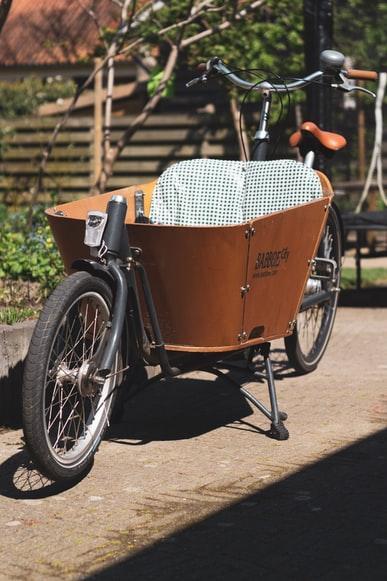Across Europe, as cities get to grips with road congestion, air pollution and meeting climate targets, the manual and electric cargo bike is rapidly delivering. Nimble, clean and efficient in urban settings, the cargo bike is quickly becoming the default transport choice for logistics companies, food delivery services and even plumbers.
‘Cargo bikes’ is a catch-all phrase for bicycles that are adapted to carry heavier or bulkier loads, or even passengers and children. For cities, the cargo bike presents a win-win at an important turning point as e-commerce companies and food delivery services continue their dizzying rise. The humble cargo bike presents businesses with a way to increase urban deliveries, improve the speed and reliability of those deliveries, while removing diesel-fuelled delivery vans from urban roads.
A recent study from climate charity and Rapid Transition Alliance member, Possible, found that electric cargo bikes deliver 60% faster than vans in urban centres, totting up higher average speeds and dropping off ten parcels an hour, compared to a van’s six. The same report found that cargo bikes cut emissions by 90% compared with diesel vans and by a third when compared with electric vans.
Cargo bikes have also revolutionised the urban school run, with some holding up to eight children becoming an increasingly common sight in Denmark, the Netherlands and, to a lesser extent, London. The result is less congested roads, more breathable air, fewer road traffic accidents, a radical drop in carbon emissions and a flourishing ecosystem of businesses that can go direct to their customers without harming the environment.
And, the cargo bike market is booming. In Germany, nearly 100,000 e-cargo bikes are sold every year, with its neighbour France ratcheting up around 50,000 sales a year. The UK is a little behind, totting up only 2,000 e-cargo bike sales for commercial use last year. But, this is only set to be temporary, with sales expected to jump by 60% this year and a market size set to increase by 15-fold within the next five years. This rate of growth is set to be mirrored across Europe too, with sales expected to increase by 50% year on year. By 2030, estimates suggest annual European sales of one million cargo bikes for commercial uses and a further one million sales for family cargo bikes.
Wider relevance
The coming age of the cargo bike provides a fascinating insight into rapid transition – and is one that can be replicated in other sectors if we can get all the ingredients right. A combination of private enterprise, government support, design and manufacturing breakthroughs, standardisation and cross-border collaboration have created the conditions where both the demand for cargo bikes, and the supply coming to market, are on an inexorable rise. Alongside these factors has been the enabling power of digital technology, where app-based platforms and digital bike-sharing schemes are increasing the accessibility to cargo bikes for city dwellers, boosting demand and visibility.
While enabled by high-tech manufacturing and improvements in battery technology, the cargo bike craze sweeping across Europe can also be understood as an effective, relatively low-tech climate solution, reorienting transport away from the fossil fuelled-vehicles towards low-impact, low-cost and long-term solutions which have multiple additional benefits. At a time when technologies – both those available and those yet to be invented – often receive disproportionate attention in climate policy debates, the rise of cargo bikes can remind us of how some of the smartest, most easily deployed tools for transition are those that we already have: they are tried and tested.
Scaling up cargo bikes in urban centres can also help lay the foundations for other low-carbon and clean air initiatives, as well as countering the worrying trend of increased car use induced by pandemic fears of using public transport. By providing a solution for industry and businesses to access their customer base and move through urban spaces without the need for cars and vans, cargo bikes can become a enabler for Low Traffic Neighbourhoods (LTNs), reducing the allocation of road space for cars which can allow pop-up gardens and Playful Streets to emerge throughout cities, where communities can play without fearing traffic. In a post-pandemic world, where the necessity of e-commerce and food delivery services are perhaps here to stay, finding ways of getting goods from A to B in a sustainable fashion is vital.
There is also a broader economic relevance, where the rising demand for cargo bikes is boosting employment in industrial heartlands. The iconic UK-based bike manufacturer, Raleigh, has only been selling cargo bikes for a few years, but they have already seen their sales increase by 75% last year at their Nottingham manufacturing facility. Raleigh recently partnered with another UK institution – the National Trust – to deploy cargo bikes at their larger sites to help with maintenance and moving supplies around. Raleigh have also partnered with the family dairy company, Jones Bros, providing them with cargo bikes for their London deliveries, replacing the diesel van they used to use for their 10-mile delivery route. With cargo bikes, we are seeing a rich array of collaborations between manufacturers and businesses, who are running pilots to garner an understanding how both their business offerings and bottom lines can be improved by the introduction of cargo bikes.
Context and background
Cargo bikes present an opportunity and solution for both local governments and businesses. Cities around the world are grappling with the issue of poisonous air, where an increase in motor traffic and congestion in urban centres is creating air which is a danger to human health – especially the health of children. Globally, air pollution kills an estimated seven million people a year. In the UK, noxious air is responsible for approximately 40,000 deaths per year. Getting cars off the roads and out of densely populated urban areas is therefore a priority for cities – and reducing the number of larger, diesel-fuelled delivery vans is the best place to start. According to data from the Department for Transport, van traffic in London has grown by 71% over the last two decades, with 47% of the 3.8 million vans registered since 1996 attributed to businesses. In London, it’s estimated that up to 14% of small van journeys in the most congested parts of the city could be made with cargo bikes. In Dublin, postal giant UPS has been trialling a cargo bike hub approach, where two e-trikes have replaced four delivery vans, removing around 500 van-delivered packages from their supply chain and cutting their Dublin-based emissions by 40%.
At the same time, the demand for e-commerce goods, food delivery services and other platform-based, convenience-fuelled ventures are clogging up urban centres with traffic, noise and making the air unbreathable. For e-commerce especially, the roaring demand for same day and next day delivery is causing logistics giants a major headache, causing them to pour in billions of investment into so-called last-mile delivery services. And while venture capitalist and techo-futurists would have you believe that autonomous postal robots are just around the corner, it is the humble cargo bike that’s allowing e-commerce to unlock the last mile puzzle. Some estimates of the financial benefits to businesses range from 70-90% cost savings compared to reliance on delivery vans. Plus, it’s not just the likes of Amazon and UPS getting on their bikes, national postal services are filling up the cargo bike manufacturers’ order books too. Ireland’s national postal service, An Post, recently ordered over 100 e-trikes from the German manufacturer Radkutsche.
The cargo bike craze is a great example of how the co-benefits of rapid transition can quickly align.
Enabling factors
Support from Government and business
The cargo bike craze has been fostered, in part, by a strong policy toolkit across Europe, ranging from local government grants and national subsidies to private business offerings. In the UK, the Department for Transport (DfT) launched their eCargo Bike Grant Fund for businesses and organisations in 2019 and has already awarded over £2 million in grants. In fact, the grant scheme has unlocked such a vast amount of demand for cargo bikes that in 2020, 58 councils across the UK submitted bids totalling £4.2 million – creating a positive problem for the UK to fill these grants to get the wheels in motion.
The business improvement district, Team London Bridge, is currently running a business engagement strategy that has been hugely successful. As part of the programme, Team London Bridge contacts businesses and organisations active with the London Bridge area and helps them bring cargo bikes into their everyday operations in order to capture the numerous benefits. In the Netherlands, a country famed for its cycling culture, the tech-firm Cargoroo has launched an app-based public cargo bike share scheme so everyone can benefit from the cargo bike.
Standardisation for safety
Despite cycling being around for hundreds of years, the cargo bike is something that is relatively modern. And as the sales of cargo bikes boom across Europe, manufacturers and industrial groups are busy creating a European cargo bike standard, which was launched last year. While there are already national standards in France and Germany, the regional growth in the cargo bike market is causing manufacturers to push for greater standardisation across the board. At the front of everyone’s minds is safety – but there are divergent opinions on issues such as bike width, payload and length. Once an agreement is reached, manufacturers will have the certainty they need to push ahead with boosting supply.
The commercial opportunity
There are plenty of financial gains from deploying cargo bikes throughout a businesses’ supply chain. From reducing the overheads of entering low emissions zones, or the mounting parking fines that many companies face, to having the speed and agility to glide through traffic or even reach areas that motorised vehicles can’t, cargo bikes look like a no-brainer for many firms operating in this space. And it’s not just logistics firms and e-commerce giants who are hopping on the cargo bike craze, many businesses that have to transfer goods as part of their service provision are exploring the potential of cargo bikes: be they plumbers, ice cream vendors or window cleaners.
Cross-city collaboration & advocacy
Alongside cross-border standardisation, comes a deeper form of collaboration. Organisations like the EU-funded CityChangerCaroBike have been expanding to partner cities all over Europe, publishing guidance and advice on scaling up cargo bikes and cycle infrastructure, as well as sharing stories of cargo-biking ‘Local Heroes’. Helping to present cities and national governments in the heart of power is the European Cycle Logistics Federation, which recently launched a strategic partnership with Cycling Industries Europe to create a more unified, stronger advocacy platform for cycling logistics businesses in Europe.
Scope and evidence
- In Germany, nearly 100,000 cargo bikes are sold every year, with its neighbour France ratcheting up around 50,000 sales a year. The UK is a little behind, totting up only 2,000 cargo bike sales for commercial use last year.
- The UK is forecast to increase by 60% this year and the market size is set to inflate by 15-fold within the next five years.
- By 2030, estimates suggest annual European sales of one million cargo bikes for commercial uses and a further one million sales for family cargo bikes.
- The UK-based bike manufacturer, Raleigh, has only been selling cargo bikes for a few years but they have already seen their sales increase by 75% last year at their Nottingham manufacturing facility.
- Sales across Europe are growing at around 50% year on year.
- A recent study from Possible found that electric cargo bikes deliver 60% faster than vans in urban centres, totting up higher average speeds and dropping off ten parcels an hour, compared to a van’s six.
- The Possible report found that cargo bikes cut emissions by 90% compared with diesel vans and by a third when compared with electric vans.
- The cargo bike boom is, in part, being driven by shifts in consumer habits that have shifted due to the ongoing Covid-19 pandemic, with the number of UK consumers doing a weekly grocery shop online doubling since the first lockdown.
- By 2030, estimates suggest annual European sales of one million cargo bikes for commercial uses and a further one million sales for family cargo bikes.
Lessons for rapid transition
- It is easy to overlook old, unglamorous technologies that can play a big, new role in rapid transition: a perfect storm of road congestion, traffic threats, air pollution and changes in how people buy things has elevated the cargo bike from a niche transport option to a mainstream delivery choice. Cargo bikes offer a win-win solution for cities, residents, safer streets, the environment and businesses alike.
- Greening growing industries early is vital to meeting climate targets: With spending habits shifting during the Covid-19 pandemic, providing low-impact and low-emissions solutions for new, expanding markets is essential.
- The public sector can be a market maker by enabling transitions: Government and business can work hand-in-hand at a local level to scale up low-impact climate solutions through grant schemes in order to capture the social and commercial benefits. And, mutual learning and collaboration across cities makes roll-out easier.
Link: https://www.resilience.org/stories/2021-08-24/large-tired-and-tested-how-europes-cargo-bike-roll-out-is-delivering/?utm_source=pocket_mylist
Source: https://www.resilience.org

















Leave a Reply